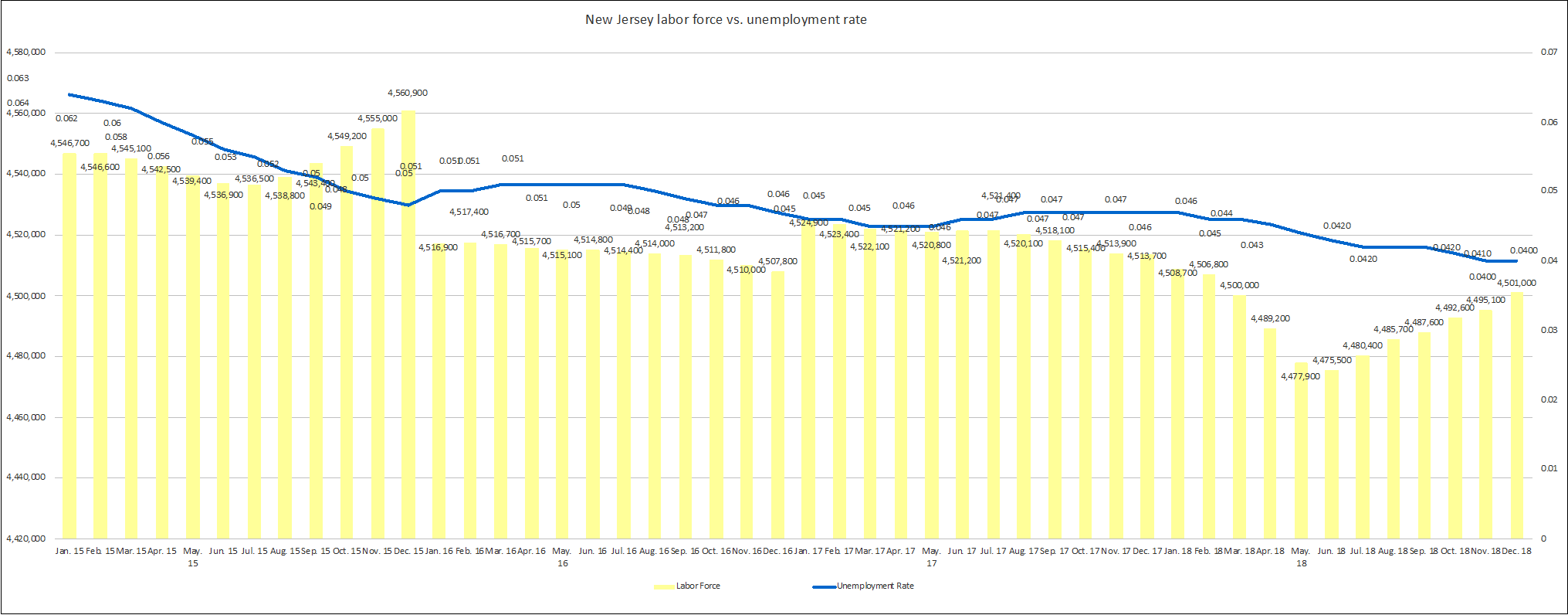Unemployment, TRANSFORMING OUR BUSINESS CLIMATE, Labor
GSI Analysis: Dec. ’18 Jobs Report: NJ Employment Picture Loses Steam, Another Sign of State Economy Falling Behind U.S.

-
NJ loses 2,300 jobs in December and workforce continues to shrink
-
Jobs report coupled with state revenue reported below projections is troubling sign for health of overall economy
-
Over the last three years, New Jersey’s workforce has shrunk the most among neighboring and competing states.
Garden State Initiative (GSI) analysis of the state’s monthly jobs report for December 2018 shows the state economy lacks forward momentum. The report showed job losses in December paired with a shrinking workforce over the year.
“This has been a troubling week for New Jersey’s economy,” said Garden State Initiative President Regina M. Egea. “We’ve seen the slow job growth of recent months come to a full stop and state revenue falling well below projections. These two reports send a clear message to the Administration to avoid further policy shifts that would hamper job creation.”
Private sector payroll jobs
NJ Labor Force vs. Unemployment Rate, 1/15-12/18
The state lost 2,300 private sector jobs in December. Most of the job losses came from white collar service industries. Over the year, New Jersey is up 61,900 private sector jobs.
The sectors that added jobs were construction (+400 jobs), manufacturing (+400 jobs), Financial Activities (+500 jobs) and other services (+900 jobs). The sectors that lost jobs were Information (-200 jobs), Professional and Business Services (-200 jobs), Leisure and Hospitality (-200 jobs), Education and Health Services (-1,500 jobs), and Trade, Transportation and Utilities (-2,400 jobs).
State workforce
In December, the state labor force grew by 5,900 individuals—its largest increase the entire year. However, despite the record growth for the year, it was not enough to bring New Jersey’s labor force in line with what it was at the beginning of 2018. In January of 2018, New Jersey’s labor force stood at 4,508,700, the state’s current labor force stands at 4,501,000 a difference of 7,700 fewer individuals.
The state’s unemployment rate remained at 4 percent for December. While the unemployment rate dropping steadily over 2018 often receives the most media attention, for the first six months of the year, the unemployment rate decreasing was largely a result of people dropping out of the state workforce altogether, causing it to shrink.
NJ Workforce Size as Compared to Competitor States, 2015-2018
Also, over the last three years, New Jersey’s workforce has shrunk the most among neighboring and competing states. Florida, Ohio, North Carolina, South Carolina and even New York saw their workforces grow since 2015. Pennsylvania’s workforce shrank over that time period but far less than New Jersey’s workforce.
New Jersey’s economic outlook
The state’s jobs report also comes the same week that Gov. Phil Murphy delivered his State of the State address, where he reiterated his campaign promises and laid out his biggest priorities for the coming year. His proposals included legalizing recreational marijuana, changing how the state awards tax incentives to businesses and much more. The Governor and legislative leaders tentatively agreed to a $15 minimum wage; the impact of which will begin to be felt in July.
The jobs report also comes the same week as the state’s monthly revenue report, which showed state revenues 10% below December 2017, with income tax receipts coming in 35.2% below the prior December, and also significantly lower than the state’s revenue projections. Of growing concern is the year-the year to date revenue growth of 2.1% significantly below the treasurer’s annual growth plan of 7.5%.
The lack of economic momentum in the state economy in 2018 paired with the fact that the state brought in significantly less revenue than it had accounted for puts New Jersey more at risk if a potential economic downturn is approaching.
Using annual averages of private sector job levels of the state, it took New Jersey nine years to fully recover the jobs lost from the 2008 recession. The next economic down cycle will very likely result in job losses in the state. Regardless of whether someone agrees with Gov. Murphy’s recent proposals, it is not obvious how they would bolster the state’s economy in a significant way or put New Jersey ahead of any neighboring or competing states.


